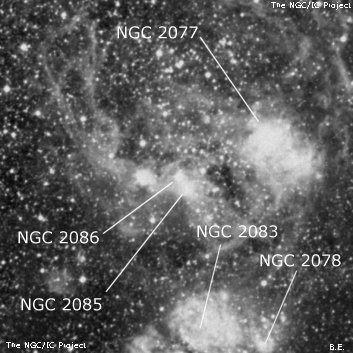
John Herschel discovered NGC 2086 = h2956 in Dec 1834 and recorded "B, pS, R, lbM, follows a star 10m with other S stars about it. Not observed in sweeping, but laid down in the drawing of Dec 4, 1837, whence its place is derived from the drawing fig 4, Pl III. JH's position and sketch clearly shows that NGC 2086 follows the mag 10 star and corresponds with a nebulous patch 12 seconds of RA following the bright star.
Williamina Fleming discovered the emission spectrum of this nebula again on an objective prism plate taken in 1901 at Arequipa. As she didn't associate it with the NGC number, Dreyer catalogued Fleming 92 (Harvard discovery number) as IC 2145. ESO, Harold Corwin and Mati Morel misidentified NGC 2086 with the mag 10 star. After Corwin was notified he corrected his identification of NGC 2086.
600/800mm - 24" (4/9/08 - Magellan Observatory, Australia): this is the eastern component of a close pair of nebulous glows with NGC 2085 just 1.2' W. This pair is part of a fascinating group of numerous emission nebulae (LMC-N160 and LMC-N159) just 35' S of the Tarantula nebula. At 200x with a UHC filter, this knot appears very bright (slightly brighter than NGC 2085), fairly small, round, ~30" diameter. Without a filter, a faint star is near the center. Mag 10 supergiant HD 269953 (misidentified as NGC 2086 in the ESO catalogue), which is nearly attached to the NE side of NGC 2085, lies 1' W.
Notes by Steve Gottlieb